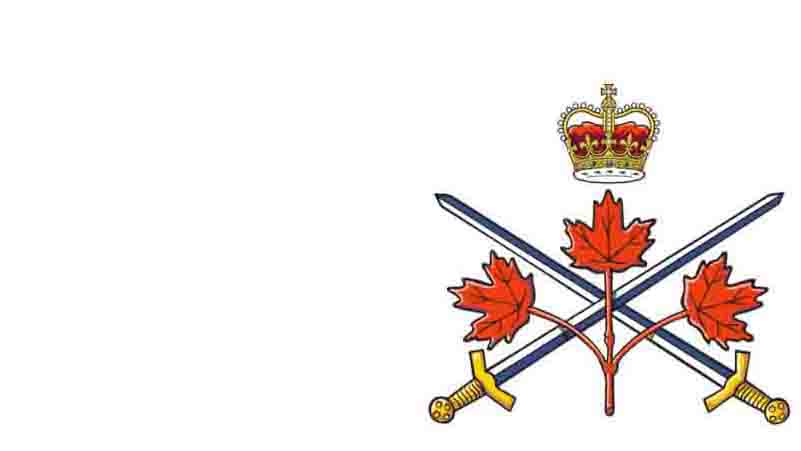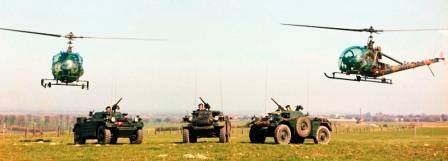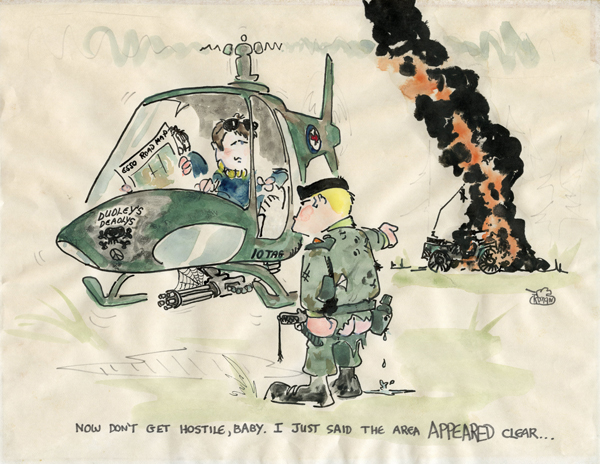Canadian Army Aviation




|
The potential for using the helicopter to support the land forces had attracted much attention from the doctrine and force development branches in the post war Canadian Army. In particular, the Royal Canadian Armoured Corps had become interested in the use of the Light Observation Helicopter to enhance the capabilities of the specialised Armoured Reconnaissance units that were responsible for the surveillance and security of major army formations.
The addition of an independent Armoured Car Reconnaissance Squadron to Canada’s NATO Brigade in 1957 provided an opportunity to put this concept into effect. A decision was made to train and equip a troop of helicopters manned by experienced armoured corps pilots and observers to be part of this Squadron in Germany. The Army’s purchase of a number of CH112 light helicopters allowed for the formation of the RCAC Helicopter Troop at the CJATC in 1961. The selection and training of personnel for this unit started in 1957 with a requirement that the officer and senior NCO applicants should have and least one regimental tour. The first group of pilots were trained at the Brandon Flying Club/LAS with their helicopter conversion with the US Army. The subsequent candidates were trained at PFS Centralia/AATTS with a helicopter conversion at BHTU followed by a Tactical RW course. The sergeants selected as observers were either trained at the AATTS or when the aircraft were deployed on the summer concentrations. This new subunit, consisting of seven helicopters, seven pilots, six observers and nine maintainers began flying operations as part of the Reconnaissance Squadron 8th Canadian Hussars at Fort Chambly near Soest in West Germany in May 1962. This designation changed to the Fort Garry Horse later in that year as the Armoured Regiments rotated through the Brigade. The troop reverted back to the Hussars for a few years and then became part of the Royal Canadian Dragoons before it was absorbed by 444 Tactical Helicopter Squadron in 1972. The role of the Squadron was to perform reconnaissance, area security and battlefield surveillance in depth and across the Brigade Group front. It consisted of a SHQ and three Troops of wheeled Ferret scout cars armed with .30 cal machine guns. The car troops operated with six cars in three sections of two cars each. The helicopter troop became the fourth troop of this squadron and also operated in three sections of two. The wheeled scout cars were later replaced by a tracked M113 ½ LYNX reconnaissance vehicle mounting a .50 cal gun but this did not require any change in the squadron’s tactics. The Squadron had the ability to rapidly deploy its scout car sections based on the ground and the tactical situation to acquire, by stealth and visual observation, the information that the Brigade needed to conduct its operations. The purpose of the helicopter troop was to speed up and improve the Brigades abilities to deploy by assisting the scout car sections to get into position and provide them with information needed to complete their tasks. The introduction of a “zero ground pressure” vehicle into the Squadrons operations was a seamless exercise from a doctrinal viewpoint since the helicopters used the same techniques used by the scout cars in that they would use ground and any cover to assist the leading scout cars to accomplish their observational tasks. The actual handling of the aircraft in this “nap of the earth” environment involved a rapid movement from a hover in one concealed position to another using a quick stop technique to remain concealed. They would then check the areas critical to the scout cars positions from different locations and altitudes when encountering gaps, blind corners and built up areas. If no cover was available the helicopters would lay back or shift to another position. If the terrain and the tactical situation were favourable the helicopter section could land and dismount the observer for short periods under certain conditions. The command and control of the helicopter troop was the responsibility of the Commanding Officer of the Reconnaissance Squadron. This would guarantee that the aircraft would be immediately available and be operationally aware of the tactical situation when their unique capabilities were required. The helicopter sections were assigned to support the scout car troops depending on the ground and the overall mission assigned to the Squadron. Since the helicopter crews were aware of the overall mission they could insert themselves into a tactical situation when requested or when the ground allowed them to provide information that would help the scout cars. The direction and co-ordination of these combined elements once the Squadron was committed to a specific task rested with the ground elements. The helicopters provided information only and were careful about manipulating the tactical situation. Another factor was that the helicopters were always aware of the positions of the scout cars and the value of their machine guns as a deterrent effect. This meant that the helicopters seldom operated ahead of the ground elements. The helicopters were also careful not to press on if the situation became confused and to avoid over exposure if no valuable information could expected to be obtained. This degree of co-operation did not require any extensive tasking orders or explanations in order to get the aircraft inserted into the tactical situation. This was because the crews were familiar with the operational drills and with the knowledge of the limitations of the aerial observations. The helicopter crews sometimes had to qualify the information given if they could not assure that there was no enemy present after a flanking sweep and this occasionally led the helicopter crew to state that, “the area appears clear” if no contact was made. 
Another important task was the adjustment of artillery since the helicopters were capable of moving into good positions to adjust fire onto targets detected by the scout cars. The helicopter was an excellent vehicle to use as an air observation post because it provided a stable observation platform that could be oriented towards the target for its two observers without entering into any critical aerodynamic situation. The pilot would orbit in a close figure of eight pattern behind cover and, based on the time of flight would then use the aircrafts ability to accelerate and make a full power climbing turn to nose over facing the target. After observing the fall of shot a right turn and a rapid collective descent would complete the manoeuvre with minimum exposure. The deployment of the helicopter troop in support of the squadron followed the conventional practices of any field unit. The troop was organized with a HQ section of a CP vehicle and a jeep and three helicopter sections. These sections of two aircraft included a ¾ ton truck towing a trailer holding three 45 gal drums of aviation fuel. The truck was manned by two aviation technicians and carried the essential tools to maintain the aircraft as well as the kit, rations and accommodation for the section. With the addition of a man pack radio the section could operate separately from the rest of the troop for short periods. Although the sections could operate independently it was a normal practice to select an advanced landing site and regroup at last light and harbour overnight as a unit. This site would be within the squadron’s operating area and was made in consideration of the need for self defence as well as the difficulties in concealing the helicopters. The machine was awkward to conceal and difficult to move on soft ground. The typical well defined german wood with its closely planted trees made it virtually impossible to move the helicopter under natural cover. The solution was to use farm buildings or small agricultural complexes with hard standing to conceal the angular shape of the helicopter. This was possible because the local farmers were aware of the military maneuver rights agreements in effect for major NATO exercises which allowed for reasonable use of private property under these conditions. Since the farmers and owners seldom objected to a request to hide the aircraft these arrangements were very welcome. Covered accommodation reduced the time taken to conceal and service the aircraft and usually included some form of inside space and other creature comforts for the crews. The many different locations occupied by the troop during these exercises varied from single large barns complete with cows, to a large rectangular farm complexes around a central paved area lined with sheds that could conceal all the vehicles and the aircraft. The bonus in one case was the gasthof in the corner of the compound which served as a crew rest area. Another location bonus was on an exercise in Northern Germany when the troop was offered accommodation in a paved vehicle compound occupied by a small trucking company. This included a security fence, overhead lighting and a closed door stall in the garage for each helicopter complete with heated workshop and washroom facilities. All this was topped off by the owner’s invitation to his house next door for supper. When thanked for the offer he said it was the least he could do for the fair treatment he received when he was a guest of the Canadian Government in Lethbridge in 1944. The Brigades annual training cycle included deployments to the established training areas for sub unit, unit and brigade level exercises cumulating in a major NATO exercise in open country in the fall. Although the helicopter troop was organic to the Reconnaissance Squadron the aircraft could be made available to the other Brigade units if the Squadron was not committed to a major operation. These external tasks were very common when the troop was in garrison or when the Brigade was undergoing sub unit training and they varied from liaison flights, scouting for locations for future exercises, route and bridging surveys and small cargo deliveries such as transporting spare fuses for the Honest John missile Battery. A major influence on the troops operations in Germany was the weather. This factor was simplified by the fact that the helicopters operated outside of controlled airspace and, with the exception of transition flights to the exercise area, they could operate in minimum visibility. The troop became very adept at reading the local weather patterns and that cloud and wind in one valley could also mean that the next valley was completely obscured. Crossing a ridge without a visual reference beyond the crest was something to be avoided. Since there was no need to fly if the visibility limited the crew’s ability to observe the issue of moving the aircraft in minimum weather only became critical if the entire Brigade was moving back and the helicopters would be at risk if left behind. This was answered by air taxing the aircraft behind a truck and stopping if the truck flashed its rear lights on encountering an overhead wire or other obstacle. The pilots became very adept at flying at minimum altitude and in reduced visibility and cultivated the necessary degree of patience needed to land and wait out the weather. The only example of a critical weather situation occurred when a helicopter returning from a local administrative flight lost visual reference with the ground when the typical Ruhr valley haze rapidly turned into a ground based cloud layer. This resulted in the non instrumented rated helicopter pilot making a radar controlled approach and a GCA to an RAF fighter station north of Soest. The inclusion of an experienced observer as part of the crew was a major contribution to the success of the helicopter in these low level operations in the forward areas. This degree of co-operation between the pilot and the observer was based on a common understanding of the tactical problems they would encounter and a division of the duties involved in the cockpit. The observer would operate the radios, assist in the map reading and produce a six figure map reference for a contact while the aircraft was in a steep turn a few feet above the ground. The effectiveness of this crew combination was particularly evident when the Troop was tasked to take part of a multinational trial to evaluate the effectiveness of the attack helicopter as an antitank weapon. This trial at Ansbach in 1971 involving US, German and Canadian LOH crews using laser equipped aircraft and tanks soon highlighted the comparative skills of the troops involved. This resulted in an inquiry from the US Army as why the Canadian LOH crews performed so much better than their US counterparts during the trials. The conclusion was that the presence of a dedicated, trained and experienced observer was the major factor in the difference in the two national groups. The RCAC Helicopter troop was a unique organization that integrated aviation resources into a specialised reconnaissance unit at the lowest possible command level. It operated for a period of ten years in a demanding operational environment with excellent safety record. During that period twenty eight officers, of which twenty one came from the armoured corps, flew as pilots with the troop. The varied backgrounds of the pilots and observers that served during this decade greatly contributed to the success of the unit. This included five members with service in Korea, two who started out as apprentice soldiers and two who had previous service in the RCAF as either a radio officer or a fighter pilot. Later careers following service with the troop resulted in four of the pilots going on to command CF Helicopter squadrons while at least two RSM appointments and one commission came from the observers that served with the troop. By 1966 it became evident that the Armoured Corps could not provide sufficient pilots to man the troop and the requirement that armoured experience was a prerequisite for employment in this role could not be sustained. This resulted in posting three infantry, three service corps and one navy pilot to the troop. The successful integration of these officers proved that previous specialised experience was not a essential for selection and that the ability to read a map, adapt to a changing tactical situation and maintain operational awareness were the major factors that assured success in this role. Although the basics of these skills could be taught by realistic training it also evident that some, more than others, had the operational curiosity and temperament to excel in this environment. Reconnaissance units at any level tend to attract those who are predisposed to operations that reward individuality and initiative. This is expressed in various forms of “esprit de corps” and the Troop certainly did not lack this characteristic. The combination of the role, the attraction of military operations in Germany and the challenges of low level flying all contributed to a high level of morale in the troop. These qualities were sustained and improved upon when the RCAC Helicopter troop was absorbed into 444 Tactical Helicopter Squadron in 1972. The following officers and non commissioned officers served in the troop during its ten year existence. They are listed in accordance with the date posted. PILOTS
OBSERVERS
|
